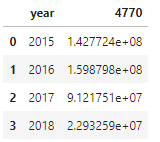PyJanitor and Pandas Method Chaining
I want to share a Python package that makes your pandas code more readable.
How do I like my pandas code
When I write code in pandas to make a dataframe, I like to write with method chaining.
For example, I might write:
import pandas as pd
raw_data = pd.read_csv('sales.csv')
df = (
raw_data
.assign(order_date = lambda _df: pd.to_datetime(_df['order_date']))
[lambda _df: _df['order_date'] >= pd.to_datetime('2019-11-09')]
.groupby(['category'], axis=1)
.agg({
'dollars': 'sum',
'volume': 'sum
})
)
instead of
import pandas as pd
raw_data = pd.read_csv('sales.csv')
raw_data['order_date'] = pd.to_datetime(raw_data['order_date'])
filtered = raw_data[raw_data['order_date'] >= pd.to_datetime('2019-11-09')]
grouped = df.groupby(['category'], axis=1)
df = grouped.agg({
'dollars': 'sum',
'volume': 'sum
})
If you come from an R background, you may have recognized the method chaining style from tidyverse piping in R with the %>% operator.
Why do I like my code this way?
Even though both returns the same thing, in my opinion, method chaining is much more readable.
Why? Because it is easier for me to track the “data flow” when I view data processing as a directed acyclic graph (DAG):

If I can group all the code for df1 together and all the code for df2 together, then I can understand where I can stop worrying about df1 or df2, when a new dataset come in, etc.
In other words, I don’t have to mentally track which variable is pointing to which dataset anymore, especially when a single script pulls in several data sources.
Let me give you an imaginary example
Code 1
df1 = do_stuff(df)
df2 = do_more_stuff(df1)
another_df1 = do_good_stuff(another_df)
another_df2 = do_more_good_stuff(another_df1)
joined = df2.merge(another_df2, on=...)
Code 2
df2 = (
df
.do_stuff()
.do_more_stuff()
)
another_df2 = (
another_df
.do_good_stuff()
.do_more_good_stuff()
)
joined = df2.merge(another_df2, on=...)
I think Code 2 is much more readable.
But my function is not a pandas method?
But how can I make a method called do_stuff() for pandas?
Many of my functions are specific to the job at hand, say
def get_sales_in_thanksgiving_week(df):
# implementation here
# ...
return output
and they are usually called with
thanksgiving_sales = get_sales_in_thanksgiving_week(df)
which breaks the nice method chaining DAG. How can I apply method chaining in this case?
Comes PyJanitor
The package pyjanitor adds to pandas many utility method chaining functions. And it allows you to add custom methods to any pandas dataframes.
- Link to pyjanitor on PyPI
- Note: currently, it requires
pandas>=0.24.0
An example
The example I use is the Avocado Prices dataset on Kaggle. You can also read the notebook here.
import pandas as pd
raw_avocados = pd.read_csv('avocado-prices.zip', index_col=0)
raw_avocados.sample(5)

Use janitor.then() to chain a function
For example, to get the yearly sales by product ID (PID), I might write a function like this:
def get_yearly_sum_by_PID(df, PID):
output = (
df
[['year', str(PID)]]
.groupby(['year'], as_index=False)
.agg({
str(PID): 'sum'
})
.sort_values('year')
)
return output
and to call it as a method, I can use pyjanitor.then() to register and functools.partial() to supply the parameters:
from janitor import then
from functools import partial
df_by_pid = (
raw_avocados
.then(partial(get_yearly_sum_by_PID, PID=4770))
)

The current design of janitor.then() only takes in functions with a single parameter: df, so I have to use functools.partial() if my function requires extra parameters.
Other handy functions
PyJanitor has other functions that may help you simplify code that you can find in the documentation. For example,
drop_cols = ['Small Bags', 'Large Bags', 'XLarge Bags']
# pandas style
df_no_bags_pd = raw_avocados.drop(drop_cols, axis=1)
# pyjanitor style
df_no_bags = raw_avocados.remove_columns(drop_cols)
df_no_bags.equals(df_no_bags_pd)
df_dt = raw_avocados.to_datetime('Date')
df_dt2 = raw_avocados.assign(Date=lambda _df: pd.to_datetime(_df['Date']))
df_dt.equals(df_dt2)
A small note
It turns out that the .then() method is a simple wrapper using the package pandas-flavor:
So, if you don’t want to use pyjanitor’s then() method to register your own method, an alternative is to follow the example in here.